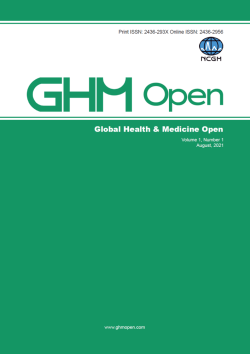Volume 2, Issue 1
Displaying 1-10 of 10 articles from this issue
- |<
- <
- 1
- >
- >|
Policy Forum
-
2022Volume 2Issue 1 Pages 1-11
Published: August 05, 2022
Released on J-STAGE: August 09, 2022
Advance online publication: September 29, 2021Download PDF (572K)
Review
-
Article type: review-article
2022Volume 2Issue 1 Pages 12-24
Published: August 05, 2022
Released on J-STAGE: August 09, 2022
Advance online publication: April 08, 2022Download PDF (2114K)
Original Article
-
Article type: research-article
2022Volume 2Issue 1 Pages 25-30
Published: August 05, 2022
Released on J-STAGE: August 09, 2022
Advance online publication: August 01, 2022Download PDF (329K) -
Article type: research-article
2022Volume 2Issue 1 Pages 31-37
Published: August 05, 2022
Released on J-STAGE: August 09, 2022
Advance online publication: January 16, 2022Download PDF (381K)
Brief Report
-
Article type: brief-report
2022Volume 2Issue 1 Pages 38-43
Published: August 05, 2022
Released on J-STAGE: August 09, 2022
Advance online publication: March 18, 2022Download PDF (462K) -
Article type: brief-report
2021Volume 2Issue 1 Pages 44-50
Published: August 05, 2022
Released on J-STAGE: August 09, 2022
Advance online publication: November 08, 2021Download PDF (471K)
Communication
-
2022Volume 2Issue 1 Pages 51-53
Published: August 05, 2022
Released on J-STAGE: August 09, 2022
Advance online publication: November 30, 2021Download PDF (325K) -
2022Volume 2Issue 1 Pages 54-58
Published: August 05, 2022
Released on J-STAGE: August 09, 2022
Advance online publication: July 09, 2022Download PDF (239K)
Letter
-
Article type: letter
2022Volume 2Issue 1 Pages 59-62
Published: August 05, 2022
Released on J-STAGE: August 09, 2022
Advance online publication: February 26, 2022Download PDF (287K) -
Article type: letter
2022Volume 2Issue 1 Pages 63-64
Published: August 05, 2022
Released on J-STAGE: August 09, 2022
Advance online publication: July 09, 2022Download PDF (251K)
- |<
- <
- 1
- >
- >|
